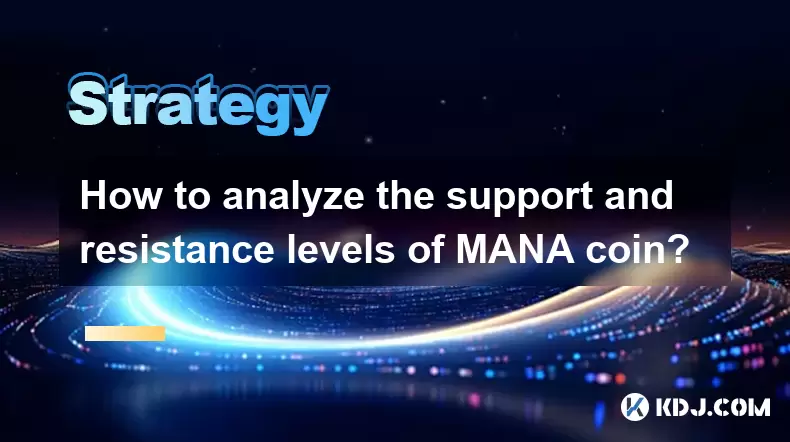-
 bitcoin
bitcoin $122659.385674 USD
0.52% -
 ethereum
ethereum $4484.113342 USD
-0.09% -
 bnb
bnb $1304.229256 USD
-0.85% -
 tether
tether $1.000204 USD
-0.03% -
 xrp
xrp $2.860636 USD
-0.51% -
 solana
solana $227.288799 USD
2.36% -
 usd-coin
usd-coin $0.999805 USD
0.01% -
 dogecoin
dogecoin $0.252837 USD
1.18% -
 tron
tron $0.341149 USD
1.12% -
 cardano
cardano $0.830507 USD
0.33% -
 hyperliquid
hyperliquid $45.792319 USD
0.04% -
 chainlink
chainlink $22.422164 USD
1.55% -
 ethena-usde
ethena-usde $1.000283 USD
0.01% -
 sui
sui $3.511389 USD
0.83% -
 stellar
stellar $0.385276 USD
-0.44%
How to analyze the support and resistance levels of MANA coin?
Analyzing MANA coin's support and resistance levels using historical data, technical indicators, and volume analysis can guide traders in making informed decisions.
May 21, 2025 at 11:35 am

Analyzing the support and resistance levels of MANA coin, the native token of the Decentraland platform, is crucial for traders and investors looking to make informed decisions. Support and resistance levels are key price levels where the forces of supply and demand meet, often leading to significant price movements. In this article, we will explore the various methods and tools used to identify these levels for MANA coin, providing a comprehensive guide for those interested in trading this digital asset.
Understanding Support and Resistance
Before diving into the specifics of analyzing MANA coin, it's essential to grasp the concept of support and resistance. Support levels are price points where a downtrend is expected to pause due to a concentration of demand. Conversely, resistance levels are where an uptrend is likely to stall due to a concentration of supply. These levels are not fixed and can change over time as market conditions evolve. For MANA coin, understanding these levels can help traders predict potential price movements and set strategic entry and exit points.
Using Historical Price Data
One of the most straightforward methods to analyze support and resistance levels for MANA coin is by examining historical price data. This involves looking at past price charts to identify levels where the price has repeatedly bounced off or broken through. For MANA, you can use platforms like CoinMarketCap or TradingView to access historical price data.
- Open a cryptocurrency charting platform such as TradingView.
- Select MANA coin from the list of available cryptocurrencies.
- Choose a time frame that suits your analysis, such as daily, weekly, or monthly charts.
- Look for recurring price levels where the price has historically found support or resistance. These could be specific price points or ranges.
- Mark these levels on your chart using horizontal lines to visualize where the price has previously reacted.
By identifying these levels, you can gain insights into potential future price movements based on historical patterns.
Utilizing Technical Indicators
Technical indicators can enhance your analysis of MANA coin's support and resistance levels. Moving averages, Bollinger Bands, and Fibonacci retracement levels are among the most commonly used tools by traders.
Moving Averages: These can help identify dynamic support and resistance levels. For MANA, you might use the 50-day and 200-day moving averages to spot trends and potential reversal points.
- Add a moving average indicator to your MANA price chart on your chosen platform.
- Adjust the period to 50 and 200 days.
- Observe how the price interacts with these moving averages. If the price consistently finds support or resistance at these lines, they can be considered significant levels.
Bollinger Bands: These can indicate overbought or oversold conditions and potential breakout points.
- Add Bollinger Bands to your MANA chart.
- Look for the price touching or breaking through the upper or lower bands. These points can signal potential reversals or continuations.
Fibonacci Retracement Levels: These are useful for identifying potential support and resistance levels based on the Fibonacci sequence.
- Identify a significant price swing in MANA's chart, such as a high and a subsequent low.
- Draw Fibonacci retracement levels from the high to the low.
- Observe how the price reacts at these levels. Common retracement levels include 38.2%, 50%, and 61.8%.
Volume Analysis
Volume is a critical component when analyzing support and resistance levels for MANA coin. High trading volume at certain price levels can indicate strong support or resistance. Conversely, low volume at these levels might suggest that the level is less significant.
- Add a volume indicator to your MANA price chart.
- Observe the volume bars at key price levels. If you see high volume at a certain level, it could indicate a strong support or resistance zone.
- Compare volume levels across different time frames to confirm the significance of these levels.
Psychological Levels
Psychological levels are round numbers that often act as support and resistance due to human psychology. For MANA coin, levels like $1, $2, or $5 can be significant because traders tend to place orders at these round figures.
- Identify round numbers on your MANA price chart.
- Observe how the price reacts at these levels. If the price frequently bounces off or struggles to break through these round numbers, they can be considered psychological support or resistance levels.
Using Multiple Time Frames
Analyzing MANA coin's support and resistance levels across multiple time frames can provide a more comprehensive view. What might appear as a support level on a daily chart could be a resistance level on a weekly chart.
- Start with a higher time frame such as weekly or monthly charts to identify long-term support and resistance levels.
- Zoom into lower time frames like daily or hourly charts to find more immediate levels.
- Compare the levels across different time frames to confirm their significance. Levels that appear on multiple time frames are generally more reliable.
Practical Example of Analyzing MANA Coin
To illustrate how to apply these methods, let's consider a practical example of analyzing MANA coin's support and resistance levels.
- Open a chart of MANA coin on TradingView.
- Select the daily time frame to start with a broader view.
- Identify historical support and resistance levels by looking at past price action. Suppose you find that MANA has repeatedly bounced off $0.50 and struggled to break through $1.00.
- Add the 50-day and 200-day moving averages to the chart. If you see that the price finds support at the 50-day moving average and resistance at the 200-day moving average, these can be considered dynamic levels.
- Add Bollinger Bands and observe any price interactions with the upper and lower bands. If the price touches the lower band at $0.50, it might indicate a strong support level.
- Draw Fibonacci retracement levels from a recent high to a low. If the price finds support at the 38.2% level, this can be another confirmation of a support zone.
- Check the volume at these levels. If you see high volume at $0.50, it reinforces the significance of this support level.
- Look at psychological levels like $0.50 and $1.00. If the price consistently reacts at these levels, they can be considered important.
- Confirm these levels by looking at the weekly chart. If $0.50 and $1.00 also appear as support and resistance on the weekly chart, they are likely more reliable.
By combining these methods, you can develop a robust analysis of MANA coin's support and resistance levels, helping you make more informed trading decisions.
Frequently Asked Questions
Q: Can support and resistance levels for MANA coin change over time?A: Yes, support and resistance levels for MANA coin can change over time as market conditions evolve. What was once a strong support level might become a resistance level if the price breaks below it, and vice versa. It's important to continually monitor and update your analysis to reflect these changes.
Q: How often should I update my analysis of MANA coin's support and resistance levels?A: It's advisable to update your analysis of MANA coin's support and resistance levels regularly, especially during periods of high volatility. Daily or weekly reviews can help you stay current with the latest market movements and adjust your trading strategy accordingly.
Q: Are there any tools or platforms specifically designed for analyzing MANA coin's support and resistance levels?A: While there are no tools specifically designed for MANA coin, general cryptocurrency charting platforms like TradingView, Coinigy, and CryptoWatch offer comprehensive tools for analyzing support and resistance levels. These platforms allow you to customize charts, add various technical indicators, and analyze price action across multiple time frames.
Q: Can I use the same methods to analyze support and resistance levels for other cryptocurrencies?A: Yes, the methods discussed in this article for analyzing MANA coin's support and resistance levels can be applied to other cryptocurrencies as well. The key is to adapt these methods to the specific price action and market conditions of the cryptocurrency you are analyzing.
Disclaimer:info@kdj.com
The information provided is not trading advice. kdj.com does not assume any responsibility for any investments made based on the information provided in this article. Cryptocurrencies are highly volatile and it is highly recommended that you invest with caution after thorough research!
If you believe that the content used on this website infringes your copyright, please contact us immediately (info@kdj.com) and we will delete it promptly.
- Shiba Inu Price Crash? Layer Brett Captures Meme Coin Spotlight
- 2025-10-09 19:05:14
- XRP Tokens: Can Owning Them Actually Make You Rich, Ya Know?
- 2025-10-09 18:45:15
- ADA Whales: Riding the Support Wave to Potential Gains?
- 2025-10-09 18:25:16
- Millionaire Trader's XRP Chart: Investor Challenge or Golden Ticket?
- 2025-10-09 19:25:12
- H Mining: Navigating Crypto Investing with Risk Mitigation
- 2025-10-09 18:45:15
- Riding the Crypto Rollercoaster: IPO Genie, Crypto Presales, and Liquidation Lessons
- 2025-10-09 18:25:16
Related knowledge

Practical parameter settings for a Bitcoin multi-timeframe moving average system
Sep 18,2025 at 10:54pm
Optimizing Timeframe Combinations for Bitcoin Trading1. Selecting appropriate timeframes is crucial when building a multi-timeframe moving average sys...

How can I filter out false breakouts in Dogecoin high-frequency trading?
Sep 22,2025 at 01:00am
Understanding False Breakouts in Dogecoin Trading1. A false breakout occurs when Dogecoin's price appears to move beyond a defined support or resistan...

Techniques for identifying tops and bottoms in the Bitcoin on-chain NVT model
Sep 20,2025 at 07:54pm
Understanding the NVT Model in Bitcoin Analysis1. The Network Value to Transactions (NVT) ratio is often described as the 'P/E ratio' of the cryptocur...

What does the surge in open interest in Bitcoincoin futures mean?
Sep 20,2025 at 11:18pm
Understanding the Surge in Dogecoin Futures Open Interest1. A surge in open interest within Dogecoin futures indicates a growing number of active cont...

How can I use the Ethereum USDT premium to gauge market sentiment?
Sep 18,2025 at 11:55pm
Understanding the Ethereum USDT Premium1. The Ethereum USDT premium refers to the price difference between USDT (Tether) traded on Ethereum-based plat...

What should I do if Ethereum staking yields decline?
Sep 20,2025 at 06:18am
Understanding the Causes Behind Declining Ethereum Staking Yields1. The Ethereum network transitioned to a proof-of-stake consensus mechanism with the...

Practical parameter settings for a Bitcoin multi-timeframe moving average system
Sep 18,2025 at 10:54pm
Optimizing Timeframe Combinations for Bitcoin Trading1. Selecting appropriate timeframes is crucial when building a multi-timeframe moving average sys...

How can I filter out false breakouts in Dogecoin high-frequency trading?
Sep 22,2025 at 01:00am
Understanding False Breakouts in Dogecoin Trading1. A false breakout occurs when Dogecoin's price appears to move beyond a defined support or resistan...

Techniques for identifying tops and bottoms in the Bitcoin on-chain NVT model
Sep 20,2025 at 07:54pm
Understanding the NVT Model in Bitcoin Analysis1. The Network Value to Transactions (NVT) ratio is often described as the 'P/E ratio' of the cryptocur...

What does the surge in open interest in Bitcoincoin futures mean?
Sep 20,2025 at 11:18pm
Understanding the Surge in Dogecoin Futures Open Interest1. A surge in open interest within Dogecoin futures indicates a growing number of active cont...

How can I use the Ethereum USDT premium to gauge market sentiment?
Sep 18,2025 at 11:55pm
Understanding the Ethereum USDT Premium1. The Ethereum USDT premium refers to the price difference between USDT (Tether) traded on Ethereum-based plat...

What should I do if Ethereum staking yields decline?
Sep 20,2025 at 06:18am
Understanding the Causes Behind Declining Ethereum Staking Yields1. The Ethereum network transitioned to a proof-of-stake consensus mechanism with the...
See all articles










































































